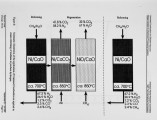| OCR Text |
Show Unmixed Combustion for Efficient Heat and American Flame Research Committee Mass Transfer in Chemical Processing Systems 1997 Fall International Symposium reactors at different temperatures, and may involve the injection of additional steam into the process. In actual practice, very large steam reformers (ca. 1,000,000 - 50,000,000 ft3/day hydrogen production) achieve 8 5 - 8 6 percent thermodynamic efficiency in converting methane to hydrogen, based on the higher heating values of the two fuels. This is achieved in part because parasitic heat losses are reduced as the process scale increases. While the large number of reactors and heat exchangers needed to produce high purity hydrogen results in high installed costs for these plants, these costs are offset by the low operating cost that results from the high overall thermodynamic efficiencies achieved. If small-to-intermediate-scale hydrogen production is to be economical, efficiencies must not deteriorate appreciably as scale is reduced. Consider that a 50 k W e fuel cell electric generator will require about 25,000 ftVday of hydrogen. However, even 25,000 ft3/day of usable hydrogen is a factor of 20 to 40 smaller than the smallest size considered practical for conventional large industrial reformers. This can be addressed with Unmixed Combustion by focussing on the issues of chemical thermodynamics and heat transfer to increase the thermodynamic efficiency of steam reforming at small scales. First, we will consider the issue of heat transfer. As already mentioned, transferring heat to a process is typically done by providing a source of heat at a temperature that is m u c h hotter than the process itself. The greater the temperature difference, the more effectively (read "efficiently") the heat is transferred. At small scales, however, parasitic heat losses from a heat source increase rapidly as the temperature is increased. With Unmixed Combustion this is addressed by transferring chemical energy to the process in lieu of heat, per se. This is done by conducting the reforming process in a cyclic fashion wherein energy is deposited chemically directly onto the catalyst in one step of the cycle, and the heat is then removed by endothermic chemical reaction in the second step. In applying Unmixed Combustion to steam reforming the nickel-based steam reforming catalyst itself can be used as the Unmixed Combustion catalyst. W h e n exposed to air, the nickel oxidizes to form nickel oxide in an exothermic (-239 kJ/mol) reaction that very effectively heats the catalyst and support. The subsequent introduction of methane will release additional energy while reducing the nickel oxide back to metallic nickel. W h e n a mixture of steam and methane are subsequently passed over this heated catalyst/ceramic support matrix the endothermic reforming reaction, Reaction 1, draws energy directly as the sensible heat of the ceramic support matrix. As Reaction 1 proceeds, the ceramic support matrix cools until the kinetics of the process become unfavorable, and then the material is regenerated by repeating the oxidation/reduction steps. Valves and heat exchangers serve to direct the exhaust and product gases appropriately, and to use the sensible heat of the reaction products to preheat the incoming reactants. This process has been demonstrated effectively both in the laboratory, and in a 20 k W c equivalent pilot plant process development unit. To date, the process has logged over 1,000 hours in the pilot plant Fairmont Hotel Chicago, Illinois September 21 -241997 Page 8 |























